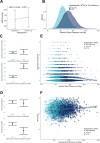Associations between mental health, blood pressure and the development of hypertension
- PMID: 37029103
- PMCID: PMC10082210
- DOI: 10.1038/s41467-023-37579-6
Associations between mental health, blood pressure and the development of hypertension
Abstract
Multiple studies have reported a link between mental health and high blood pressure with mixed or even contradictory findings. Here, we resolve those contradictions and further dissect the cross-sectional and longitudinal relationship between mental health, systolic blood pressure, and hypertension using extensive psychological, medical and neuroimaging data from the UK Biobank. We show that higher systolic blood pressure is associated with fewer depressive symptoms, greater well-being, and lower emotion-related brain activity. Interestingly, impending hypertension is associated with poorer mental health years before HTN is diagnosed. In addition, a stronger baseline association between systolic blood pressure and better mental health was observed in individuals who develop hypertension until follow-up. Overall, our findings offer insights on the complex relationship between mental health, blood pressure, and hypertension, suggesting that-via baroreceptor mechanisms and reinforcement learning-the association of higher blood pressure with better mental health may ultimately contribute to the development of hypertension.
© 2023. The Author(s).
Conflict of interest statement
The authors declare no competing interests.
Figures





Similar articles
-
Cross-Sectional and Longitudinal Associations of Systolic Blood Pressure With Quality of Life and Depressive Mood in Older Adults With Cardiovascular Risk Factors: Results From the Observational DIAST-CHF Study.Psychosom Med. 2018 Jun;80(5):468-474. doi: 10.1097/PSY.0000000000000591. Psychosom Med. 2018. PMID: 29742752
-
Blood pressure and performance on the Mini-Mental State Examination in the very old. Cross-sectional and longitudinal data from the Kungsholmen Project.Am J Epidemiol. 1997 Jun 15;145(12):1106-13. doi: 10.1093/oxfordjournals.aje.a009073. Am J Epidemiol. 1997. PMID: 9199540
-
Differences in knowledge of hypertension by age, gender, and blood pressure self-measurement among the Israeli adult population✰.Heart Lung. 2019 Jul-Aug;48(4):339-346. doi: 10.1016/j.hrtlng.2019.02.001. Epub 2019 Feb 20. Heart Lung. 2019. PMID: 30795917
-
Associations of urinary orosomucoid, N-acetyl-β-D-glucosaminidase, and albumin with blood pressure and hypertension after 7 years. The Tromsø Study.Blood Press. 2022 Dec;31(1):270-283. doi: 10.1080/08037051.2022.2128043. Blood Press. 2022. PMID: 36193001
-
The pressure's on: understanding neurocognitive and psychological associations with pediatric hypertension to inform comprehensive care.Pediatr Nephrol. 2021 Dec;36(12):3869-3883. doi: 10.1007/s00467-021-05077-w. Epub 2021 Apr 22. Pediatr Nephrol. 2021. PMID: 33890179 Review.
Cited by
-
Designing a meditation module to affect etiological and preventive factors in primary hypertensive patients-A pilot study.Physiol Rep. 2025 Feb;13(3):e70226. doi: 10.14814/phy2.70226. Physiol Rep. 2025. PMID: 39916293 Free PMC article.
-
Physical Health Among Adults with Depressive Symptoms in Qatar: Findings from Qatar Biobank Population-Based Study.Int J Environ Res Public Health. 2025 May 2;22(5):726. doi: 10.3390/ijerph22050726. Int J Environ Res Public Health. 2025. PMID: 40427842 Free PMC article.
-
Psychological stress among hypertensive male patients in Jordan: prevalence and associated factors.BMC Public Health. 2024 Dec 18;24(1):3508. doi: 10.1186/s12889-024-20733-0. BMC Public Health. 2024. PMID: 39695470 Free PMC article.
-
Risk of Mental Disorders in Polycystic Ovary Syndrome: Retrospective Cohort Study of a Korean Nationwide Population-Based Cohort.Int J Womens Health. 2025 Mar 5;17:627-638. doi: 10.2147/IJWH.S490673. eCollection 2025. Int J Womens Health. 2025. PMID: 40061289 Free PMC article.
-
Association of mental health in childhood, adolescence and young adulthood with cardiovascular risk factors and carotid remodeling below age 30 - results from the KiGGS cohort study.Eur J Epidemiol. 2025 Jan;40(1):17-26. doi: 10.1007/s10654-024-01189-3. Epub 2025 Jan 3. Eur J Epidemiol. 2025. PMID: 39751700 Free PMC article.
References
Publication types
MeSH terms
LinkOut - more resources
Full Text Sources
Medical

